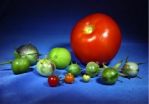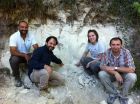(Press-News.org) In 2012, the "Mars One" project, led by a Dutch nonprofit, announced plans to establish the first human colony on the Red Planet by 2025. The mission would initially send four astronauts on a one-way trip to Mars, where they would spend the rest of their lives building the first permanent human settlement.
It's a bold vision — particularly since Mars One claims that the entire mission can be built upon technologies that already exist. As its website states, establishing humans on Mars would be "the next giant leap for mankind."
But engineers at MIT say the project may have to take a step back, at least to reconsider the mission's technical feasibility.
The MIT researchers developed a detailed settlement-analysis tool to assess the feasibility of the Mars One mission, and found that new technologies will be needed to keep humans alive on Mars.
For example, if all food is obtained from locally grown crops, as Mars One envisions, the vegetation would produce unsafe levels of oxygen, which would set off a series of events that would eventually cause human inhabitants to suffocate. To avoid this scenario, a system to remove excess oxygen would have to be implemented — a technology that has not yet been developed for use in space.
Similarly, the Mars Phoenix lander discovered evidence of ice on the Martian surface in 2008, suggesting that future settlers might be able to melt ice for drinking water — another Mars One goal. But according to the MIT analysis, current technologies designed to "bake" water from soil are not yet ready for deployment, particularly in space.
The team also performed an integrated analysis of spare-parts resupply — how many spare parts would have to be delivered to a Martian colony at each opportunity to keep it going. The researchers found that as the colony grows, spare parts would quickly dominate future deliveries to Mars, making up as much as 62 percent of payloads from Earth.
As for the actual voyage to Mars, the team also calculated the number of rockets required to establish the first four settlers and subsequent crews on the planet, as well as the journey's cost.
According to the Mars One plan, six Falcon Heavy rockets would be required to send up initial supplies, before the astronauts' arrival. But the MIT assessment found that number to be "overly optimistic": The team determined that the needed supplies would instead require 15 Falcon Heavy rockets. The transportation cost for this leg of the mission alone, combined with the astronauts' launch, would be $4.5 billion — a cost that would grow with additional crews and supplies to Mars. The researchers say this estimate does not include the cost of developing and purchasing equipment for the mission, which would further increase the overall cost.
Olivier de Weck, an MIT professor of aeronautics and astronautics and engineering systems, says the prospect of building a human settlement on Mars is an exciting one. To make this goal a reality, however, will require innovations in a number of technologies and a rigorous systems perspective, he says.
"We're not saying, black and white, Mars One is infeasible," de Weck says. "But we do think it's not really feasible under the assumptions they've made. We're pointing to technologies that could be helpful to invest in with high priority, to move them along the feasibility path."
"One of the great insights we were able to get was just how hard it is to pull this [mission] off," says graduate student Sydney Do. "There are just so many unknowns. And to give anyone confidence that they're going to get there and stay alive — there's still a lot of work that needs to be done."
Do and de Weck presented their analysis this month at the International Astronautical Congress in Toronto. Co-authors include MIT graduate students Koki Ho, Andrew Owens, and Samuel Schreiner.
Simulating a day on Mars
The group took a systems-based approach in analyzing the Mars One mission, first assessing various aspects of the mission's architecture, such as its habitat, life-support systems, spare-parts requirements, and transportation logistics, then looking at how each component contributes to the whole system.
For the habitat portion, Do simulated the day-to-day life of a Mars colonist. Based on the typical work schedule, activity levels, and metabolic rates of astronauts on the International Space Station (ISS), Do estimated that a settler would have to consume about 3,040 calories daily to stay alive and healthy on Mars. He then determined crops that would provide a reasonably balanced diet, including beans, lettuce, peanuts, potatoes, and rice.
Do calculated that producing enough of these crops to sustain astronauts over the long term would require about 200 square meters of growing area, compared with Mars One's estimate of 50 square meters. If, as the project plans, crops are cultivated within the settlers' habitat, Do found that they would produce unsafe levels of oxygen that would exceed fire safety thresholds, requiring continuous introduction of nitrogen to reduce the oxygen level. Over time, this would deplete nitrogen tanks, leaving the habitat without a gas to compensate for leaks.
As the air inside the habitat continued to leak, the total atmospheric pressure would drop, creating an oppressive environment that would suffocate the first settler within an estimated 68 days.
Possible solutions, Do says, might include either developing a technology to extract excess oxygen or isolating the crops in a separate greenhouse. The team even considered using nitrogen extracted from the Martian atmosphere, but found that doing so would require a prohibitively large system. Surprisingly, the cheapest option found was to supply all the food required from Earth.
"We found carrying food is always cheaper than growing it locally," Do says. "On Mars, you need lighting and watering systems, and for lighting, we found it requires 875 LED systems, which fail over time. So you need to provide spare parts for that, making the initial system heavier."
Twisting the knobs
As the team found, spare parts, over time, would substantially inflate the cost of initial and future missions to Mars. Owens, who assessed the resupply of spare parts, based his analysis on reliability data derived from NASA repair logs for given components on the ISS.
"The ISS is based on the idea that if something breaks, you can call home and get a new part quickly," says Owens. "If you want a spare part on Mars, you have to send it when a launch window is open, every 26 months, and then wait 180 days for it to get there. If you could make spares in-situ, that would be a massive savings."
Owens points to technologies such as 3-D printing, which may enable settlers to manufacture spare parts on Mars. But the technology as it exists today is not advanced enough to reproduce the exact dimensions and functions of many space-rated parts. The MIT analysis found that 3-D printers will have to improve by leaps, or else the entire Mars settlement infrastructure will have to be redesigned so that its parts can be printed with existing technology.
While this analysis may make the Mars One program look daunting, the researchers say the settlement-analysis tool they've developed may help determine the feasibility of various scenarios. For example, rather than sending crews on one-way trips to the planet, what would the overall mission cost be if crews were occasionally replaced?
"Mars One is a pretty radical idea," Schreiner says. "Now we've built a tool that we can play around with, and we can twist some of the knobs to see how the cost and feasibility of the mission changes."
INFORMATION:
Some of the students on this project were supported by NASA fellowships.
Written by Jennifer Chu, MIT News Office
Images/Release: http://newsoffice.mit.edu/2014/technical-feasibility-mars-one-1014
Mars One -- and done?
MIT team independently assesses the technical feasibility of the proposed Mars One mission
2014-10-14
ELSE PRESS RELEASES FROM THIS DATE:
New sequencing reveals genetic history of tomatoes
2014-10-14
This week, an international team of researchers, led by the Chinese Academy of Agricultural Sciences in Beijing, published in the journal Nature Genetics a brief genomic history of tomato breeding, based on sequencing of 360 varieties of the tomato plant.
The C.M. Rick Tomato Genetics Resource Center at UC Davis played an important role in this study by providing seed of both cultivated tomato varieties and related wild species.
This study, which builds on the first tomato genome sequence completed just two years ago, shows in great detail how the processes of early ...
Photopharmacology: Optical control of insulin secretion
2014-10-14
Researchers at Ludwig-Maximilians-Universitaet (LMU) in Munich have chemically modified an anti-diabetic agent so as to make its action dependent on light. The resulting prototype compound, termed JB253, induces release of insulin only when pancreas cells are exposed to blue light.
Synthetic, light-sensitive, molecular switches can be utilized to control biochemical signaling processes in living cells. In a new study, a research team led by LMU Professor Dirk Trauner (Chemical Biology and Genetics) and his colleague Johannes Broichhagen, in collaboration with Prof. Guy ...
Earth's magnetic field could flip within a human lifetime
2014-10-14
Imagine the world waking up one morning to discover that all compasses pointed south instead of north.
It's not as bizarre as it sounds. Earth's magnetic field has flipped – though not overnight – many times throughout the planet's history. Its dipole magnetic field, like that of a bar magnet, remains about the same intensity for thousands to millions of years, but for incompletely known reasons it occasionally weakens and, presumably over a few thousand years, reverses direction.
Now, a new study by a team of scientists from Italy, France, Columbia University ...
House fly genome reveals expanded immune system
2014-10-14
ITHACA, N.Y. – Scientists have sequenced the house fly genome for the first time, revealing robust immune genes, as one might expect from an insect that thrives in pathogen-rich dung piles and garbage heaps.
The research, published Oct. 14 in the journal Genome Biology, will increase understanding of house fly genetics and biology and of how flies quickly adapt to resist insecticides, which could lead to novel control methods.
Adult house flies (Musca domestica) carry and transmit more than 100 human and animal diseases, including salmonellosis, anthrax, typhoid ...
NASA's Aqua satellite spots Central Pacific's Tropical Storm Ana
2014-10-14
NASA's Aqua satellite passed over Tropical Storm Ana on Monday, Oct. 13 after it formed in the Central Pacific Ocean.
Ana formed on Oct. 13 at 5 p.m. EDT (11 a.m. HST) as Tropical Depression 2-C, about 920 miles (1,480 km) east-southeast of Hilo, Hawaii. By 9 p.m. EDT that day, the depression had strengthened into Tropical Depression Ana.
NASA's Aqua satellite passed over Tropical Storm Ana on Monday, Oct. 13 at 11:11 UTC (7:11 a.m. EDT) and the Atmospheric Infrared Sounder or AIRS instrument gathered infrared data that showed some strong thunderstorms and cold cloud ...
1934 drought was worst of the last millennium, study finds
2014-10-14
WASHINGTON, DC— The 1934 drought was by far the most intense and far-reaching drought of the last 1,000 years in North America, and was caused in part by an atmospheric phenomenon that may have also led to the current drought in California, according to a new study.
New research finds that the extent of the 1934 drought was approximately seven times larger than droughts of comparable intensity that struck North America between 1000 A.D. and 2005, and nearly 30 percent worse than the next most severe drought that struck the continent in 1580.
"We noticed that ...
Building a bridge from basic botany to applied agriculture
2014-10-14
One of the planet's leading questions is how to produce enough food to feed the world in an increasingly variable climate. The Food and Agriculture Organization of the United Nations predicts that food production must rise 70% over the next 40 years to feed a growing global population, and plants are one major component of the necessary rise in food production. Plants—grains, cereals, fruits, vegetables, and more—feed humans directly and indirectly by supporting livestock. Current research must tap into our knowledge of how plants work to develop more efficient ...
This week from AGU: Glacier health check, world ocean atlas, liquid brines on Mars
2014-10-14
From AGU's blogs: Health check reveals how glacier is declining due to warming climate http://blogs.agu.org/geospace/2014/10/13/health-check-reveals-glacier-declining-due-warming-climate/
Researchers from the British Geological Survey have taken the very first comprehensive health check of a rapidly melting glacier. Their latest study reveals that their icy patient, the Falljökull glacier in southeast Iceland, has been dramatically declining as it tries to adjust to recent changes in the climate.
The new findings on Falljökull show unhealthy changes in the ...
Social trust eroded in Chinese product-tampering incident
2014-10-14
URBANA, Ill. – For about a decade, Chinese consumers weren't getting what they paid for when they purchased Wuchang, a special brand of gourmet rice that has a peculiar scent. The quality was being diluted when less expensive rice was aromatized, added to the packages of the high-quality rice, and sold at the premium price. Researchers at the University of Illinois studied how the tampering scandal affected the public's perception of risk and their subsequent behavior.
Because public anxiety over the fake rice issue was more pronounced in urban districts, the researchers ...
Stem cell discovery challenges dogma on how fetus develops; holds insights for liver cancer and reg
2014-10-14
A Mount Sinai-led research team has discovered a new kind of stem cell that can become either a liver cell or a cell that lines liver blood vessels, according to a study published today in the journal Stem Cell Reports. The existence of such a cell type contradicts current theory on how organs arise from cell layers in the embryo, and may hold clues to origins of, and future treatment for, liver cancer.
Thanks to stem cells, humans develop from a single cell into a complex being made up of more than 200 cell types. The original, single human stem cell, the fertilized embryo, ...
LAST 30 PRESS RELEASES:
Heart-brain connection: international study reveals the role of the vagus nerve in keeping the heart young
Researchers identify Rb1 as a predictive biomarker for a new therapeutic strategy in some breast cancers
Survey reveals ethical gaps slowing AI adoption in pediatric surgery
Stimulant ADHD medications work differently than thought
AI overestimates how smart people are, according to HSE economists
HSE researchers create genome-wide map of quadruplexes
Scientists boost cell "powerhouses" to burn more calories
Automatic label checking: The missing step in making reliable medical AI
Low daily alcohol intake linked to 50% heightened mouth cancer risk in India
American Meteorological Society announces Rick Spinrad as 2026 President-Elect
Biomass-based carbon capture spotlighted in newly released global climate webinar recording
Illuminating invisible nano pollutants: advanced bioimaging tracks the full journey of emerging nanoscale contaminants in living systems
How does age affect recovery from spinal cord injury?
Novel AI tool offers prognosis for patients with head and neck cancer
Fathers’ microplastic exposure tied to their children’s metabolic problems
Research validates laboratory model for studying high-grade serous ovarian cancer
SIR 2026 delivers transformative breakthroughs in minimally invasive medicine to improve patient care
Stem Cell Reports most downloaded papers of 2025 highlight the breadth and impact of stem cell research
Oxford-led study estimates NHS spends around 3% of its primary and secondary care budget on the health impacts of heat and cold in England
A researcher’s long quest leads to a smart composite breakthrough
Urban wild bees act as “microbial sensors” of city health.
New study finds where you live affects recovery after a hip fracture
Forecasting the impact of fully automated vehicle adoption on US road traffic injuries
Alcohol-related hospitalizations from 2016 to 2022
Semaglutide and hospitalizations in patients with obesity and established cardiovascular disease
Researchers ‘listen in’ to embryo-mother interactions during implantation using a culture system replicating the womb lining
How changing your diet could help save the world
How to make AI truly scalable and reliable for real-time traffic assignment?
Beyond fragmented markets: A new framework for efficient and stable ride-pooling
Can shape priors make road perception more reliable for autonomous driving?
[Press-News.org] Mars One -- and done?MIT team independently assesses the technical feasibility of the proposed Mars One mission



